| Saavira Kambada Basadi | |
|---|---|
Tribhuvana Tilaka Cūḍāmaṇi | |
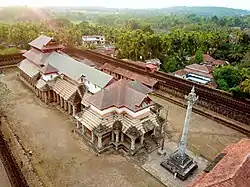 Sāvira Kambada Temple, Karnataka | |
| Religion | |
| Affiliation | Jainism |
| Deity | Chandraprabhu |
| Festivals | Mahavir Jayanti |
| Governing body | Shri Moodabidri Jain Matha |
| Bhattaraka | Charukeerti Panditacharya Varya |
| Location | |
| Location | Moodabidri, Karnataka |
| Geographic coordinates | 13°04′27.3″N 74°59′51.5″E / 13.074250°N 74.997639°E |
| Architecture | |
| Creator | Devaraya Wodeyar |
| Date established | 1430 AD |
| Temple(s) | 18 |
| Website | |
| www | |
| Part of a series on |
| Jainism |
|---|
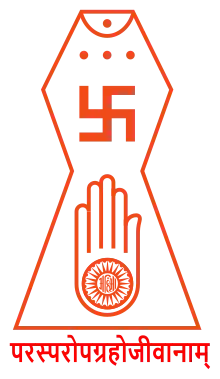 |
Saavira Kambada Temple (Sāvira Kambada Basadi) or Tribhuvana Tilaka Cūḍāmaṇi), is a basadi or Jain temple noted for its 1000 pillars in Moodabidri, Karnataka, India. The temple is also known as "Chandranatha Temple" since it honours the tirthankara Chandraprabha, whose eight-foot idol is worshipped in the shrine.[1][2]
The town of Moodabidri is noted for its 18 Jain temples, but Saavira Kambada Temple is considered the finest among them.[3][4] The temple is considered an architectural wonder and is a major attraction of Moodabidri.
History
The Basadi was built by the local chieftain, Devaraya Wodeyar in 1430 and took 31 years to complete,[5] additions to temples were made in 1962. The shrine has a 50 feet tall monolith manasthambha erected by Karkala Bhairava Queen Nagala Devi.[6][7]
Architecture
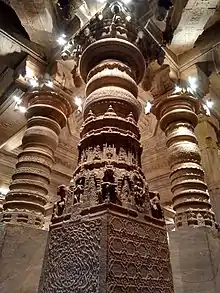
The temple is considered an architectural wonder.[8] The temple is full of elaborate sculptures and decoration. The doorway of the temple has intricate carvings and is enclosed with ornate walls. The massive pillars of the temple are carved to resemble an octagonal wooden log with one baring inscription.[9][10][11] The 1000 pillars with exquisite detail, support the temple and no two pillars are alike.[12] The sloping roof of veranda are made of wood coated with copper tiles resembling the temples of Nepal. The temple complex has seven mandapas supported by beautifully carved pillars built in the Vijayanagara style.[13] The main mandapa of the temple consists of two interconnected column halls.[14] The fourth mandapa houses a sculpture of Bhairavadevi.[7] The top two storeys are carved in wood and the lowest one in stone.[6]
The hall interiors are massive, with elaborately decorated columns and a door flanked by two protector deities. The wooden panels inside the temples have carvings of Tirthankara flanked by elephants, guardian deities and female attendants holding flowers. Several bronze Jain idols in ornated frames are placed inside the garbhagriha.[15] The 8 ft idol of Chandranatha Swami made of panchadhatu present in the garbha griha.[6] The temple are built similar to temples in Nepal. The interiors of the temple are richly and variedly carved. A large number of tombs of Jain monks are present near the temple premise. The manastambha in front of the temple is noteworthy.[16] The pillars inside the hall bear carvings of dragon and giraffe resulting from the influence of trade with China in 15th century.[17] The image of Nandishwar-dweep dated 16th century is notable.[18]
Saavira Kambada Basadi along with Shravanabelagola, Kamal Basadi and Brahma Jinalaya are considerest the most important Jain centers in Karnataka.[19][20]
Other Jain Temples in Moodabidri
.JPG.webp)
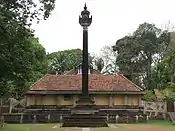
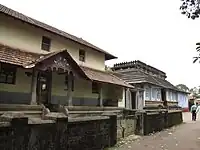
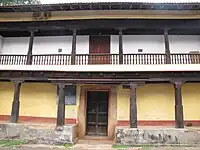
Guru Basadi
Guru basadi is the earliest of the Jain monuments built in 714 AD. A black stone idol of Parshwanatha, about 3.5 metres (11 ft) tall, is installed in the sanctum of this basadi.[21] The temples also house 12th-century Jain palm leaf manuscripts known as ‘Dhavala texts’ are preserved. These texts were brought from shravanabelagola to here during the Mughal invasion. This basadi is also called Siddantha Basadi and Hale Basadi.[3]
Other
Moodabidri is noted for its 18 Jain Temples mentioned as follows:[22]
- Bagada Basadi
- Settara Basadi
- Hire Basadi
- Guru Basadi
- Leppada Basadi
- Kallu Basadi
- Batkana-Thikari Basadi
- Pathshala Basadi
- Padu Basadi
- Kere Basadi
- Hosa Basadi
- Bitkeri Basadi
- Vikram Shetty Basadi
- Mahadeva Shetty Basadi
- Chola Shetty Basadi
- Koti Shetty Basadi
- Derma Shetty Basadi
- Ammanavara Basadi
Moodabidri Jain Math
There is a matha at Moodabidri responsible for the upkeep and maintenance of temples in Moodabidri.[23] It is known as the Jain Varanasi of the South.[21][24]
Bhaṭṭāraka Charukeerthi
A bhaṭṭāraka seat exists at Moodabidri responsible for administering the 18 temples at Moodabidri and the other temples in the surrounding areas. The name given to the bhaṭṭāraka of Moodabidri is Charukeerthi.[23][25]
In popular culture
The temple is listed as one of the temples in the Fodor's "India's Jain Temples Are Incredible Architectural Marvels" series.[26]
Gallery
 Idol of Chandraprabha, 8th Thirthankara
Idol of Chandraprabha, 8th Thirthankara Painting depicting universe as per Jain cosmology
Painting depicting universe as per Jain cosmology Painting depicting Jambudvipa
Painting depicting Jambudvipa Painting depicting Kalpavriksha
Painting depicting Kalpavriksha.jpg.webp) Tombs of Jain monk near the temple
Tombs of Jain monk near the temple Savira Kambada Basadi - Back side View
Savira Kambada Basadi - Back side View Thousand Pillar Temple View from back Side
Thousand Pillar Temple View from back Side Thousand Piller Temple - Aerial View
Thousand Piller Temple - Aerial View
See also
References
Citation
- ↑ Ramnarayan 2005.
- ↑ "Nerenki.com". nerenki.com.
- 1 2 Colaco 2015.
- ↑ Pinto 2018.
- ↑ Moodbidri Municipal Council.
- 1 2 3 Venkataraman 2013.
- 1 2 "Pillar in front of Chandranatha Jain temple, Mudbidri". British Library. Retrieved 1 July 2022.
- ↑ Paul 2019, p. 18.
- ↑ Sewell 1882, p. 235.
- ↑ Fergusson 1876, p. 271.
- ↑ Raman 1994, p. 65.
- ↑ Rao 2020.
- ↑ Fergusson 1876, pp. 271–272.
- ↑ Abram 2003, p. 252.
- ↑ Michell 2012, p. 226.
- ↑ Balfour 1885, p. 146.
- ↑ Kanisetti 2022.
- ↑ Cort 2010, p. 71.
- ↑ Butalia & Small 2004, p. 367.
- ↑ Panikar 2010, p. 408.
- 1 2 Titze & Bruhn 1998, p. 47.
- ↑ Titze & Bruhn 1998, p. 46.
- 1 2 The Hindu 2012.
- ↑ Chavan 2005, p. 323.
- ↑ Raghuram 2012.
- ↑ Binayak 2020.
Sources
Books
- Abram, David (2003). The Rough Guide to India. Rough Guide Travel Guides (4th ed.). Rough Guides. ISBN 9781843530893.
- Balfour, Edward (1885). The Cyclopædia of India and of Eastern and Southern Asia: Commercial, Industrial and Scientific, Products of the Mineral, Vegetable, and Animal Kingdoms, Useful Arts and Manufactures. Vol. 1. Bernard Quaritch.
- Butalia, Tarunjit Singh; Small, Dianne P. (2004). Religion in Ohio: Profiles of Faith Communities. Ohio University Press. ISBN 978-0-8214-1551-1.
- Chavan, Shakuntala Prakash (2005). Jainism in Southern Karnataka: (up to AD 1565). D.K. print world. ISBN 978-81246-0315-4.
- Cort, John E. (2010). Framing the Jina: Narratives of Icons and Idols in Jain History. Oxford University Press. ISBN 978-0-19-538502-1.
- Fergusson, James (1876). A History of Architecture in All Countries: From the Earliest Times to the Present Day. Vol. 3. John Murray. Retrieved 2 December 2018.
- Michell, George (2012). Southern India. Bangalore: Roli Books. ISBN 9788174369031.
- Panikar, Agustin (2010). Jainism: History, Society, Philosophy and Practice. Lala Sunder Lal Jain research series. Vol. 24. Delhi: Motilal Banarsidass. ISBN 978-81-208-3460-6.
- Paul, George S. (2019). Vasundhara - Odyssey of a Dancer. Chennai: Notion Press. ISBN 978-1-64587-531-4.
- Raman, Afried (1994). Bangalore - Mysore. Bangalore: Orient Blackswan. ISBN 9780863114311.
- Sewell, Robert (1882). New Imperial Series. The Imperial Gazetteer of India. Vol. 7. E. Keys, at the government press.
- Titze, Kurt; Bruhn, Klaus (1998). Jainism: A Pictorial Guide to the Religion of Non-Violence (2 ed.). Motilal Banarsidass. ISBN 978-81-208-1534-6.
Web
- Kanisetti, Anirudh (7 April 2022). "Why is a dragon carved on Jain temple in Mangalore? Medieval Africa-China trade holds answer". ThePrint. Retrieved 9 April 2022.
- Ramnarayan, Gowri (24 April 2005). "Moodbidri — woods of yore". The Hindu. Chennai. Archived from the original on 26 April 2005. Retrieved 15 July 2018.
- Raghuram, M. (12 December 2012). "Rooting for heritage tag for Moodbidri". Daily News and Analysis. Retrieved 15 July 2018.
- Special Correspondent (10 December 2012). "Jain festival begins in Moodbidri". The Hindu. Retrieved 15 July 2018.
- Venkataraman, S. (29 April 2013). "Circuit of calm, devotion". Deccan Herald. Retrieved 2 December 2018.
- Colaco, Hazel (11 May 2015). "The myriad moods of Moodabidri". Deccan Herald. Retrieved 2 December 2018.
- Pinto, Stanley (1 December 2018). "When Morgan Freeman left Dakshin Kannada seer amazed". The Times of India. Retrieved 2 December 2018.
- Rao, Bindu Gopal (8 March 2020). "The Jain Trail". Retrieved 15 January 2021.
- Moodbidri Municipal Council. "About TMC". The Moodbidri Town Municipal Council. Retrieved 25 July 2021.
- Binayak, Pooja (19 August 2020). "India's Jain Temples Are Incredible Architectural Marvels". Fodor's.
External links
![]() Media related to 1000 Pillar Temple (Moodabidri) at Wikimedia Commons
Media related to 1000 Pillar Temple (Moodabidri) at Wikimedia Commons